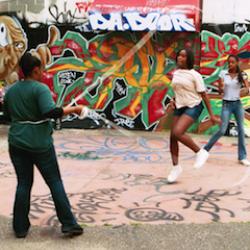Source Institutions
Source Institutions
Add to list Go to activity
Activity link broken? See if it's at the internet archive

This activity (page 2 of the PDF under SciGirls Activity: Double Dutch) is a full inquiry investigation into whether hearing or seeing has a bigger effect on jump rope performance. Groups of learners will plan a Double Dutch jump routine and count the number of moves before the jumper trips. Then, learners test the routine while the jumper listens to slow music and again while listening to fast music. Learners collect data, produce a table comparing average performance per auditory stimulus, and consider the validity of their results. An optional extension activity asks learners to investigate how a strobe light affects jump rope performance. Relates to linked video, DragonflyTV: Double Dutch.
- 10 to 30 minutes
- 1 to 2 hours
- $5 - $10 per group of students
- Ages 8 - 14
- Activity, Experiment/Lab Activity, Lesson/Lesson Plan
- English
Quick Guide
Materials List (per group of students)
- 2 ropes for jumping Double Dutch
- a large open space with flat floor or surface
- an mp3 player with ear buds
- rhythmic mp3 files, some at a slow tempo, some at a fast tempo
- optional: a strobe light
Subjects
-
Life Sciences
-
Human Body
- The Brain and Nervous System
-
Human Senses and Perception
- Vision
- Hearing
- Perception
-
Human Body
-
Mathematics
- Algebra
-
Data Analysis and Probability
- Data Analysis
- Data Collection
- Data Representation
-
Measurement
- Rate
- Number and Operations
- Reasoning and Proof
- Representation
-
The Nature of Technology
-
The Design Process
- Problem Solving
-
The Design Process
-
Physical Sciences
-
Vibration and Waves
- Sound
-
Vibration and Waves
-
The Nature of Science
-
The Scientific Process
- About Inquiry
- Asking Questions
- Conducting Investigations
- Gathering Data
- Formulating Explanations
- Communicating Results
-
The Scientific Process
Informal Categories
- Music
- Outdoor Activity
- Physical Activity
- Sports and Exercise
Audience
To use this activity, learners need to:
- see
- hear
- be mobile
- touch
Learning styles supported:
- Involves teamwork and communication skills
- Involves hands-on or lab activities
Culture, ethnicity, and gender
-
Girls
- Highlights STEM opportunities for this group
- Identifies role models or mentors in STEM fields from this group
- Uses inclusive images of people from this group
Other
Components that are part of this resource:
This resource is part of:
Access Rights:
- Free access
By:
Source Collection
- DragonflyTV
Rights:
- All rights reserved, Twin Cities Public Television, Inc., 2006
Funding Source:
- National Science Foundation, 436260
